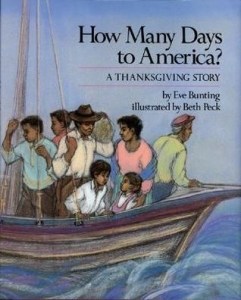An Arts Integrated Thanksgiving Project
3 Min Read • Holidays
By 3rd grade, students have done their fair share of turkey crafts. Instead of a traditional Thanksgiving lesson or unit, I extend my instruction using the book How Many Days to America: A Thanksgiving project Story by Eve Bunting. This book is a story of present-day immigrants, showing the conditions they left, what they left behind, and the risks traveling in a small boat presented in exchange for freedom in America. This is a deep topic for my 3rd graders, but I think the eye-opening content provides great opportunities to discuss why the author chose not to include names of characters or specific setting. It also lets us discuss perspective, theme, and the illustrations’ role in telling the story.
After reading, I share a tiered of Thanksgiving project for students to complete during their independent workshop time. It not only requires the students to go back to the text and use critical thinking skills, it allows them to experiment with pastel techniques, sketching, and blending colors. Each workshop is set up so that I can teach a mini-lesson on our core reading program or on a topic of student need. I then use the last few minutes to share tips on the use of pastels. (As I have no background in visual art, collaboration with our art teacher was extremely helpful for this.) I’m also lucky to have a friend who is a very talented painter, and he visited my class as a visiting artist to demonstrate drawing and sketching basics.
The goa
For this Thanksgiving project, I allow students to choose their own level. If I see a student choosing a level that I feel is too easy for him or her, I encourage that student to level up. Sometimes saying a simple, “I would love to see what you’d do with the third option,” is just the push a student needs to take a risk. After one such discussion, not only did the student choose the third option, she also chose to draw her illustration from the character’s perspective.
One of the reasons I like doing this Thanksgiving project is because I am able to see my students in a different light. We work so hard on ELA standards that to see a student who is struggling to reach proficiency in ELA create an incredible interpretation of these illustrations just blows me away. It is also so interesting to watch my students’ creative process. A few actually struggle with trying to “perfect” their artwork, even though our emphasis is the opposite of perfection– erasers are off limits for this Thanksgiving project. I love to see students looking so peaceful as they shade and mix their colors. What a great way to recharge (while meeting standards) during the school day!
Here are my directions for students, which could easily be adapted for other picture books:
- Level 1: Copy the sentence that inspired your artwork. Make sure your spelling and grammar are perfect and that your handwriting is beautiful.
- Level 2: Write a new sentence, using the author’s style, that COULD fit in the book. Your artwork should relate to your sentence. Make sure your spelling and grammar are perfect and that your handwriting is beautiful.
- Level 3: Pretend you are one of the characters in the story. Write a journal entry from that character’s perspective describing something that happened in the book. Be creative, but make sure to base your ideas on what really happened in the story, like historical fiction. Make sure your spelling and grammar are perfect and that your handwriting is beautiful.




